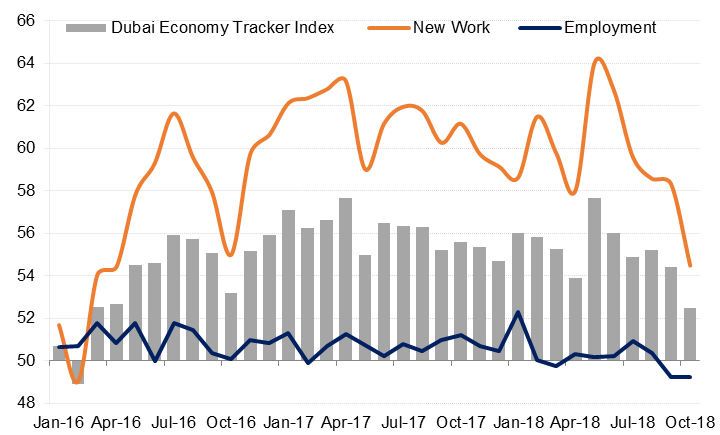
The headline Dubai Economy Tracker Index fell to 52.5 in October, down from 54.4 in October and the lowest reading since March 2016. While still in expansion territory, the headline index points to the slowest rate of growth in the private sector in more than two and half years. The travel & tourism sector weighed on the overall index, as it contracted marginally last month.
Both output and new orders across the whole of Dubai’s private sector increased in October, but at markedly slower rates. Output growth was the weakest year-to-date, while new order growth was the slowest since April 2016.
The employment index remained in contraction territory for the second month in a row, as more firms reported a decline in headcount than those reporting an increase. However, the vast majority of firms surveyed reported no change in job numbers in October.
Margin pressures intensified last month, as input costs rose at a slightly faster rate than in September, while output (selling) prices declined on average. Stocks of inventories also declined last month, the first time this has happened since February 2016.
Despite the soft survey data, firms in Dubai were the most optimistic than they have been since at least 2012, with nearly 77% of respondents expecting their output to be higher in a year’s time.
 Source: IHS Markit, Emirates NBD Research
Source: IHS Markit, Emirates NBD Research
The travel & tourism sector index declined further to 49.6 in October from 51.3 in September, the lowest reading since February 2016 and signalling a contraction in the sector last month.
The main driver was a decline in the new work index to 49.4 as 29% of firms in the sector reported fewer new orders in October compared with the previous month. Output increased on average in October but at the slowest rate this year.
Firms faced higher input cost inflation in October, but were unable to pass this on to customers, and prices charged declined again last month. Unsurprisingly, employment in the sector fell further in October, with the employment index in contraction territory for the third month in a row at 48.6.
The strength of the USD, particularly with respect to the RUB, INR, PKR and CNY likely weighed on demand for tourism services last month, as these countries account for more than a quarter of international visitors to Dubai.
The wholesale & retail trade sector index declined to 53.7 in October from 55.5 in September, indicating a slower pace of growth in the sector last month. Both output and new orders increased a slower rate despite the steepest price discounting since January 2017. Employment in the sector was broadly unchanged after declining modestly in September, and there was little sign of higher input costs on average.
Business optimism reached a record high in October with 83% of firms surveyed expecting their output to be higher in a year’s time, and only 3% expecting output to be lower.
The construction sector index rose to 55.5 in October from 53.8 in September, with output rising sharply (64.1) and new work growth accelerating as well (58.5). However, some of the increase in new orders was likely due to price discounting - firms reduced selling prices for the second month a row despite slightly higher input costs.
Employment in the construction sector increased modestly in October, although the rate of job growth was softer than in Q2 and Q3. Stocks of purchases declined for the fourth month in a row in October, even as construction sector firms remained highly upbeat about their future prospects.
Click here to download the full report.